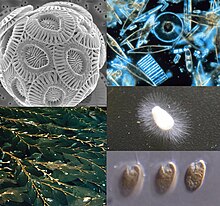Chromalveolata
| Chromalveolata
| |
|---|---|
| Chromalveolata | |
 Searah jarum jam, dari atas kiri: Haptophyta, beberapa diatom, Oomycota, Cryptophyta, dan Macrocystis (sejenis alga coklat) | |
| Taksonomi | |
| Superdomain | Biota |
| Superkerajaan | Eukaryota |
| Tanpa takson | Chromalveolata |
| Filum | |
Chromalveolata adalah supergrup eukariota yang diusulkan pada tahun 2005 dan dijadikan sebagai salah satu dari enam kelompok utama eukariota.[1] Usulan ini merupakan penyempurnaan dari kerajaan Chromista, yang diusulkan oleh Thomas Cavalier-Smith pada tahun 1981. Chromalveolata diusulkan untuk mewakili organisme yang diturunkan dari endosimbiosis sekunder tunggal yang melibatkan alga merah dan bikonta.[2] Plastida pada organisme ini mengandung klorofil c.
Namun, karakter monofili Chromalveolata telah ditolak. Dua penelitian yang diterbitkan pada tahun 2008 menguraikan pohon filogenetika yang menggambarkan bahwa Chromalveolata terpecah,[3][4] dan penelitian terbaru terus mendukung pandangan ini.[5][6]
Referensi[sunting | sunting sumber]
- ^ Adl, Sina M.; Simpson, Alastair G. B.; Farmer, Mark A.; Andersen, Robert A.; Anderson, O. Roger; Barta, John R.; Bowser, Samuel S.; Brugerolle, Guy; Fensome, Robert A. (2005-10). "The New Higher Level Classification of Eukaryotes with Emphasis on the Taxonomy of Protists". The Journal of Eukaryotic Microbiology (dalam bahasa Inggris). 52 (5): 399–451. doi:10.1111/j.1550-7408.2005.00053.x. ISSN 1066-5234.
- ^ Keeling, Patrick J. (2009-01). "Chromalveolates and the Evolution of Plastids by Secondary Endosymbiosis". Journal of Eukaryotic Microbiology (dalam bahasa Inggris). 56 (1): 1–8. doi:10.1111/j.1550-7408.2008.00371.x.
- ^ Burki, Fabien; Shalchian-Tabrizi, Kamran; Pawlowski, Jan (2008-08-23). "Phylogenomics reveals a new 'megagroup' including most photosynthetic eukaryotes". Biology Letters (dalam bahasa Inggris). 4 (4): 366–369. doi:10.1098/rsbl.2008.0224. ISSN 1744-9561. PMC 2610160
 . PMID 18522922.
. PMID 18522922.
- ^ Kim, Eunsoo; Graham, Linda E. (2008-07-09). Redfield, Rosemary Jeanne, ed. "EEF2 Analysis Challenges the Monophyly of Archaeplastida and Chromalveolata". PLoS ONE (dalam bahasa Inggris). 3 (7): e2621. doi:10.1371/journal.pone.0002621. ISSN 1932-6203. PMC 2440802
 . PMID 18612431.
. PMID 18612431.
- ^ Burki, Fabien; Okamoto, Noriko; Pombert, Jean-François; Keeling, Patrick J. (2012-06-07). "The evolutionary history of haptophytes and cryptophytes: phylogenomic evidence for separate origins". Proceedings of the Royal Society B: Biological Sciences (dalam bahasa Inggris). 279 (1736): 2246–2254. doi:10.1098/rspb.2011.2301. ISSN 0962-8452. PMC 3321700
 . PMID 22298847.
. PMID 22298847.
- ^ Burki, Fabien; Kaplan, Maia; Tikhonenkov, Denis V.; Zlatogursky, Vasily; Minh, Bui Quang; Radaykina, Liudmila V.; Smirnov, Alexey; Mylnikov, Alexander P.; Keeling, Patrick J. (2016-01-27). "Untangling the early diversification of eukaryotes: a phylogenomic study of the evolutionary origins of Centrohelida, Haptophyta and Cryptista". Proceedings of the Royal Society B: Biological Sciences (dalam bahasa Inggris). 283 (1823): 20152802. doi:10.1098/rspb.2015.2802. ISSN 0962-8452. PMC 4795036
 . PMID 26817772.
. PMID 26817772.
Bacaan lanjutan[sunting | sunting sumber]
- Patron, N. J., Rogers, M. B. and Keeling, P. J. 2004. Gene replacement of fructose-1,6-bisphophate aldolase supports the hypothesis of a single photosynthetic ancestor of chromalveolates. Eukaryot. Cell. 3, 1169-1174. [1]
- Harper, J. T. & Keeling, P. J. 2003. Nucleus-encoded, plastid-targeted glyceraldehyde-3-phosphate dehydrogenase (GAPDH) indicates a single origin for chromalveolate plastids. Mol. Biol. Evol. 20, 1730-1735.
- Archibald, J. M. & Keeling, P. J. 2002. Recycled plastids: a "green movement" in eukaryotic evolution. Trends Genet., 18, 577-584.
- Fast, N. M., Kissinger, J. C., Roos, D. S., & Keeling, P. J. 2001. Nuclear-encoded, plastid-targeted genes suggest a single common origin for apicomplexan and dinoflagellate plastids. Mol. Biol. Evol., 18, 418-426.
- Cavalier-Smith, T. 1999. Principles of protein and lipid targeting in secondary symbiogenesis: Euglenoid, dinoflagellate, and sporozoan plastid origins and the eukaryote family tree. J. Eukaryot. Microbiol. 46:347–66.
